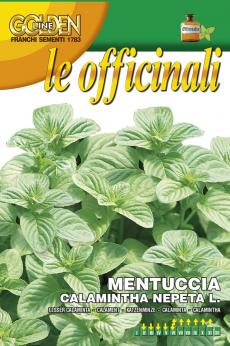
Mint, Mentuccia Calamintha Nepeta L. or Nepitella
Mentuccia - Calamintha Nepeta Calamintha nepeta) Growing wild throughout much of central and southern Italy, Mentuccia has a low mounding habit similar to oregano with brilliant green slightly fuzzy leaves. Starting as a distinct mound, it continues its growth well into fall becoming quite large and lush! The flavor is often described as somewhat of a cross between oregano or marjoram and a pure mint, with unique herbal and savory undertones beneath the more forward menthol notes. Popular in Tuscany, it is often used with dishes featuring mushrooms or fatty meats. In southern Italy, it is sometimes brewed for tea or used to flavor cheeses. In Rome it is used for Carciofi alla Romana: artichoke stuffed with bread crumbs, garlic mentuccia, and olive oil and braised in white wine. The plant likes well-drained soil and sunshine, but generally needs little and is unfussy. A short-lived perennial it will claim its spot in the garden by reseeding, but not in a quest-to-world-domination type way. Its delicate pink blooms are very popular with the pollinator crowd and at its peak last year on the farm, it was a who’s who of bees, butterflies, and beneficials! Lovely addition to any kitchen herb garden.
This is a perennial plant, rustic and easy to grow. Also known as Mentuccia and Nepitella. Can grow to around 12-18" in height and it has characteristic oval leaves and an aroma similar to mint. It is used to flavor dishes in cooking and in herbal teas. The plant resists low temperatures and also drought. Can be cultivated in containers.
Nepitella is an herb that grows wild in Italy, particularly in Tuscany and Umbria and may even be found growing amidst cobblestone pathways. This perennial, from the mint family, also goes by the name Lesser Calaminth, and is called mentuccia in Italy. Today the plant has spread and may be found growing in Southern Europe to Great Britain. The culinary herb is rare in Australia, but it is so easy to grow!
Nepitella attracts bees and is considered to be an ornamental shrub that does well in garden borders. It has pale lavender flowers and a similar appearance to Calamint, but with smaller leaves and a muskier oregano or savory-like aroma. Nepitella grows into a small mound to about 12-18" high, with soft, shiny green oregano like leaves.
Nepitella grows best in full sun to partial shade and seems to have tolerance to a wide range of growing conditions and soil types. It is a hardy plant and shows frost tolerance. When water is available Nepitella prefers free draining soils, but it does do well in dry conditions. It does well in pots.
Nepitella is considered a vital Tuscan herb and may be used to flavor anything savory, including roast meats, mushrooms, pizzas, artichokes or even pasta dishes. Many cooks have said they never cook mushrooms without using this herb. However, it should be used sparingly as it may overpower some dishes. The leaves may be used fresh or dried, but dried is considered to be stronger.
Medicinal Uses: In medieval times Nepitella was used for stomach problems and as a digestive aid, as a soothing tea and as a treatment for insomnia. This herb should be avoided by pregnant and breastfeeding women, in medicinal quantities.
Carciofi in umido con la nepitella -- Braised artichokes with calamint via Atusi
This is one of those dishes that tastes even better the next day, so plan ahead if you wish. You might like to add the herbs just before serving so they remain fresh and bright green, but Artusi adds them to the cooking artichokes.
Remove the hard, inedible outer leaves from the artichokes and slice into quarters (or into six if we’re talking large artichokes). Dust them in flour and sauté them in some olive oil in a pan. Season with salt and pepper. Once they begin to get some color, add some finely chopped garlic and a handful of fresh nepitella, calamint. Finish cooking in some tomato sugo or tomato paste dissolved in some water.
